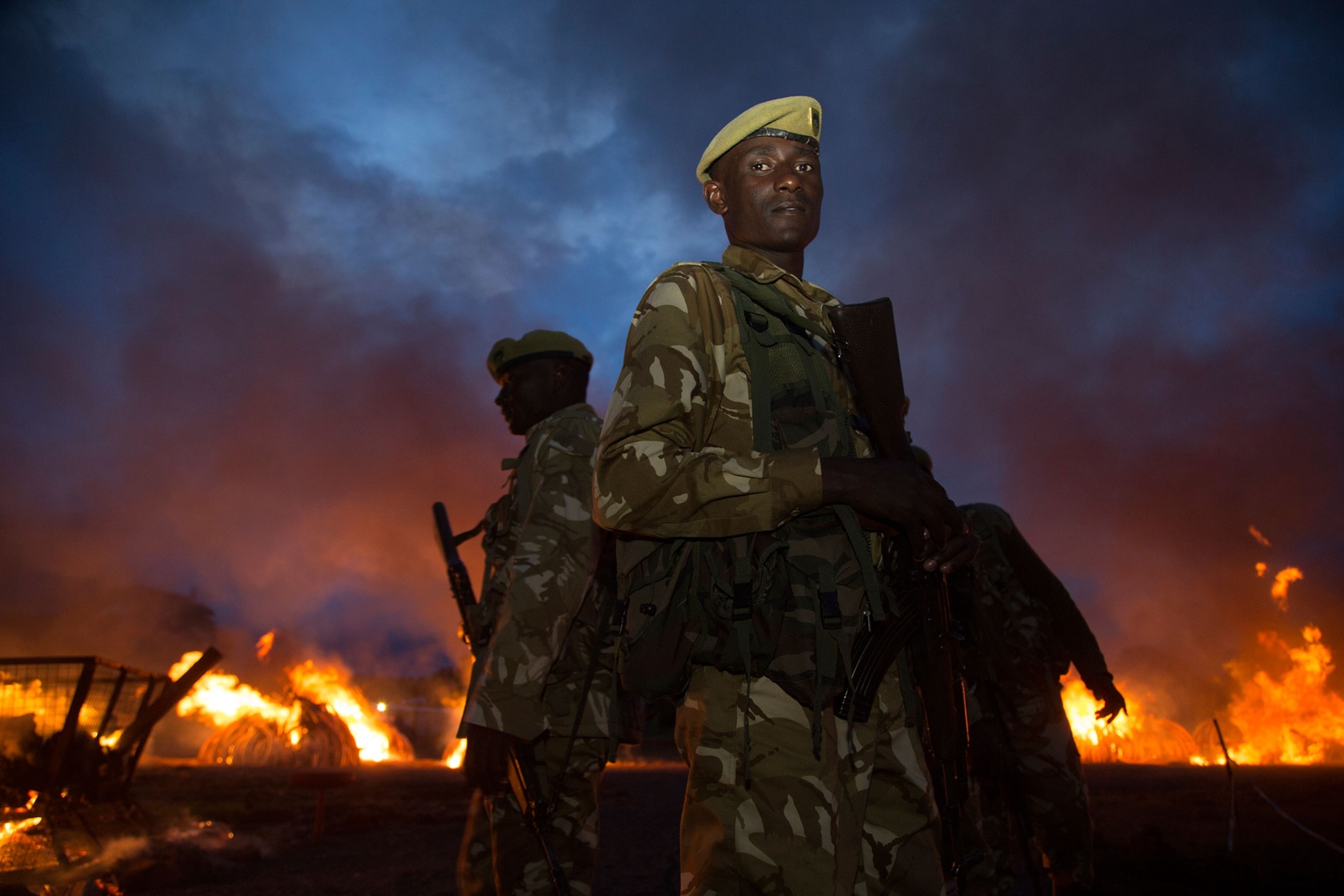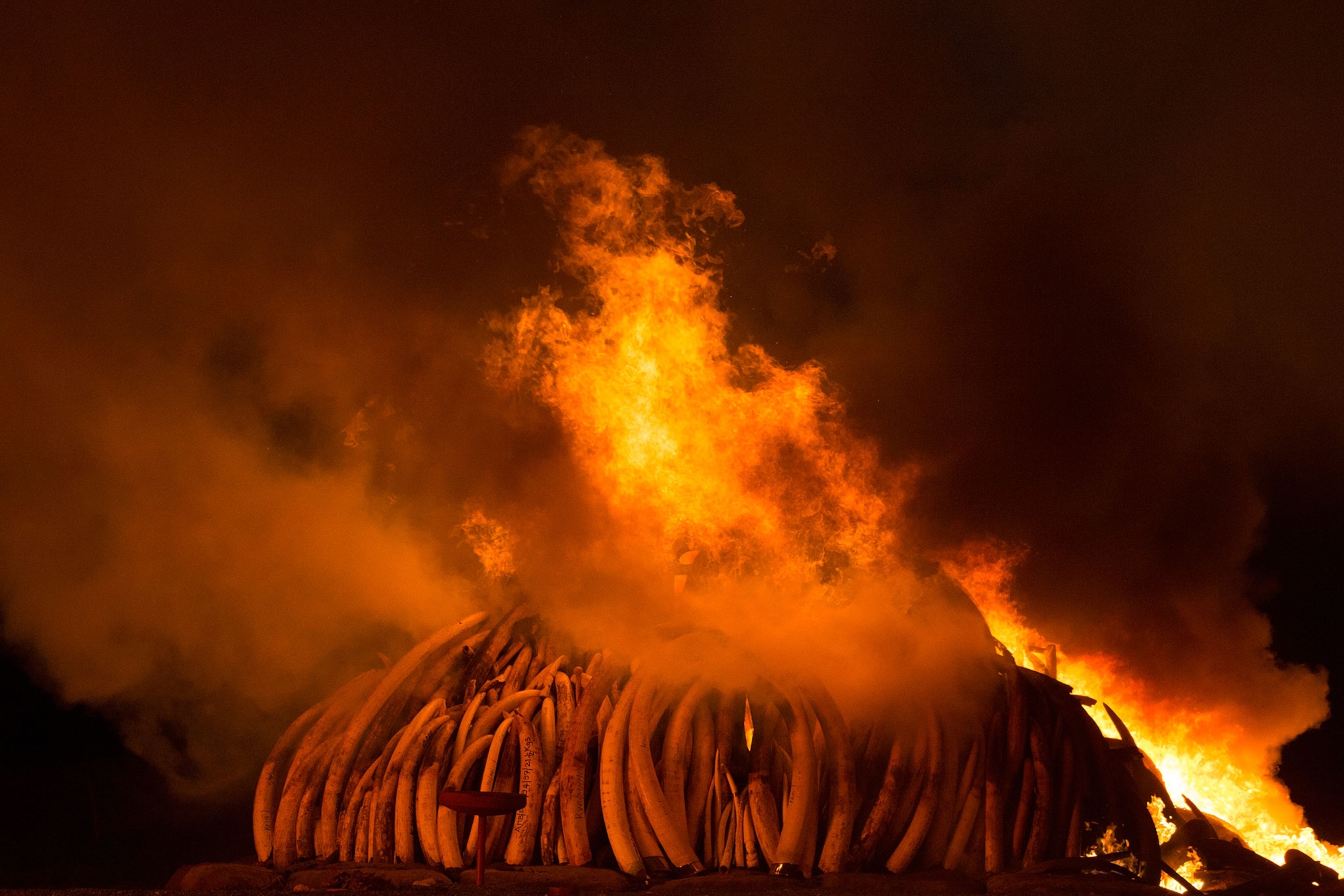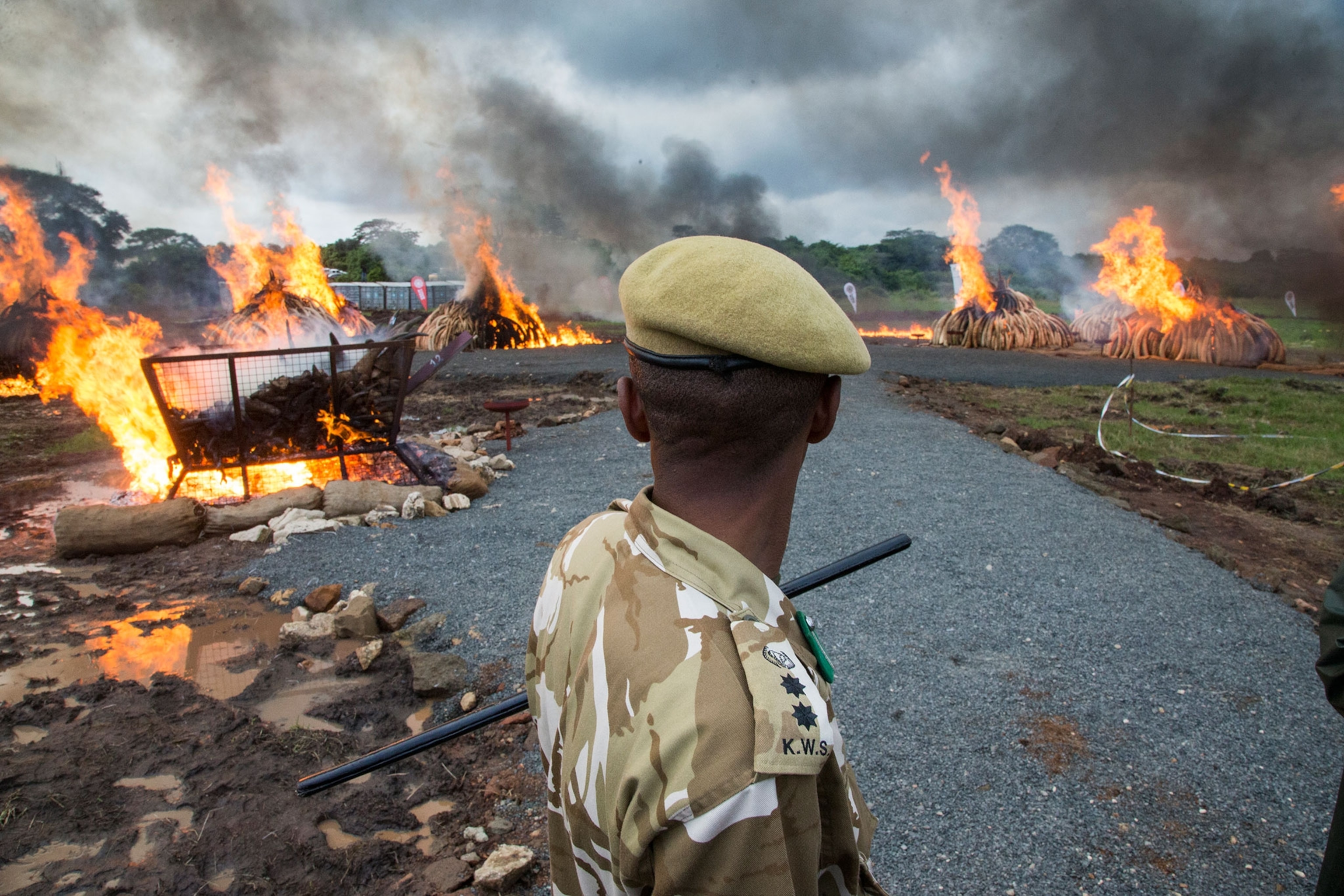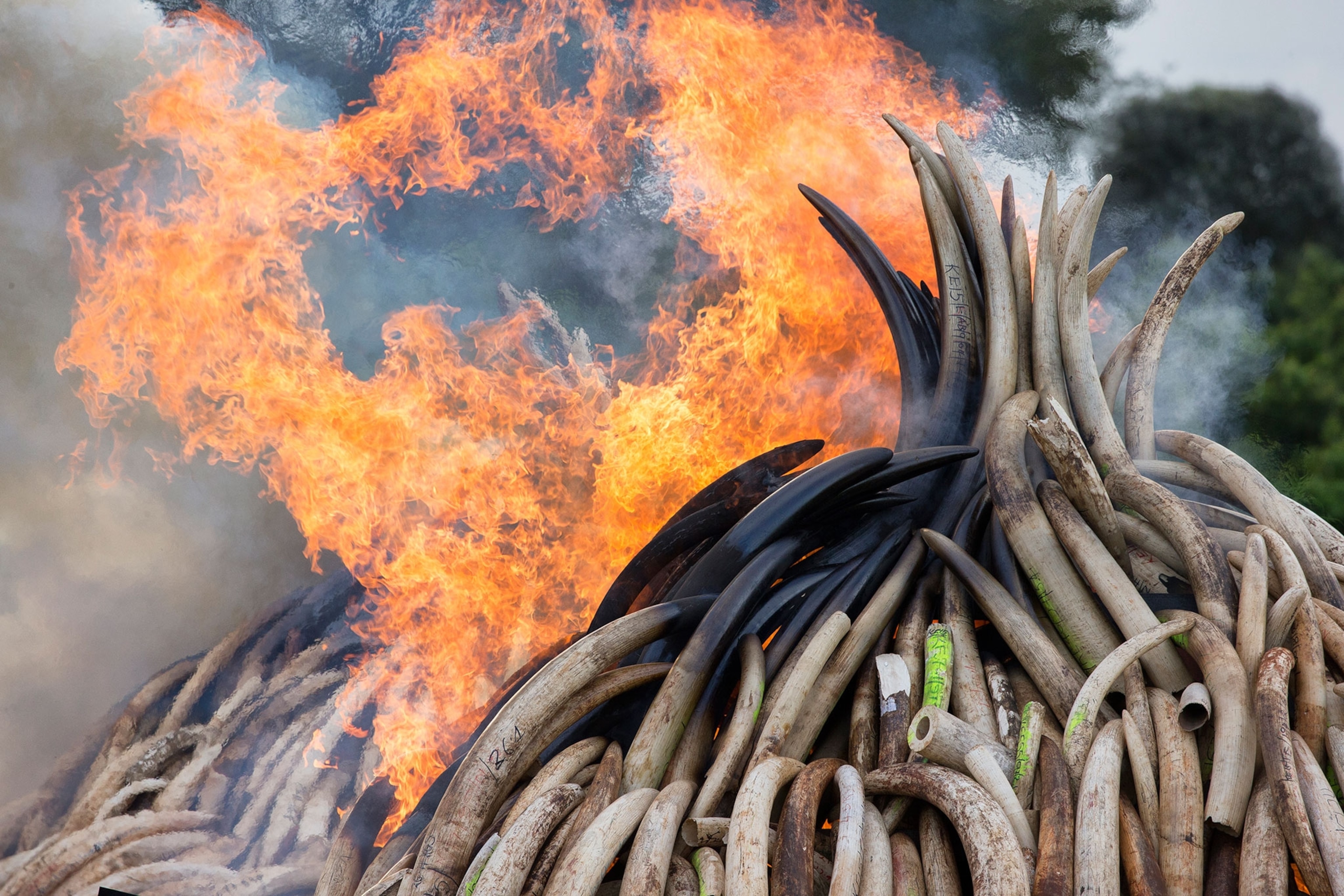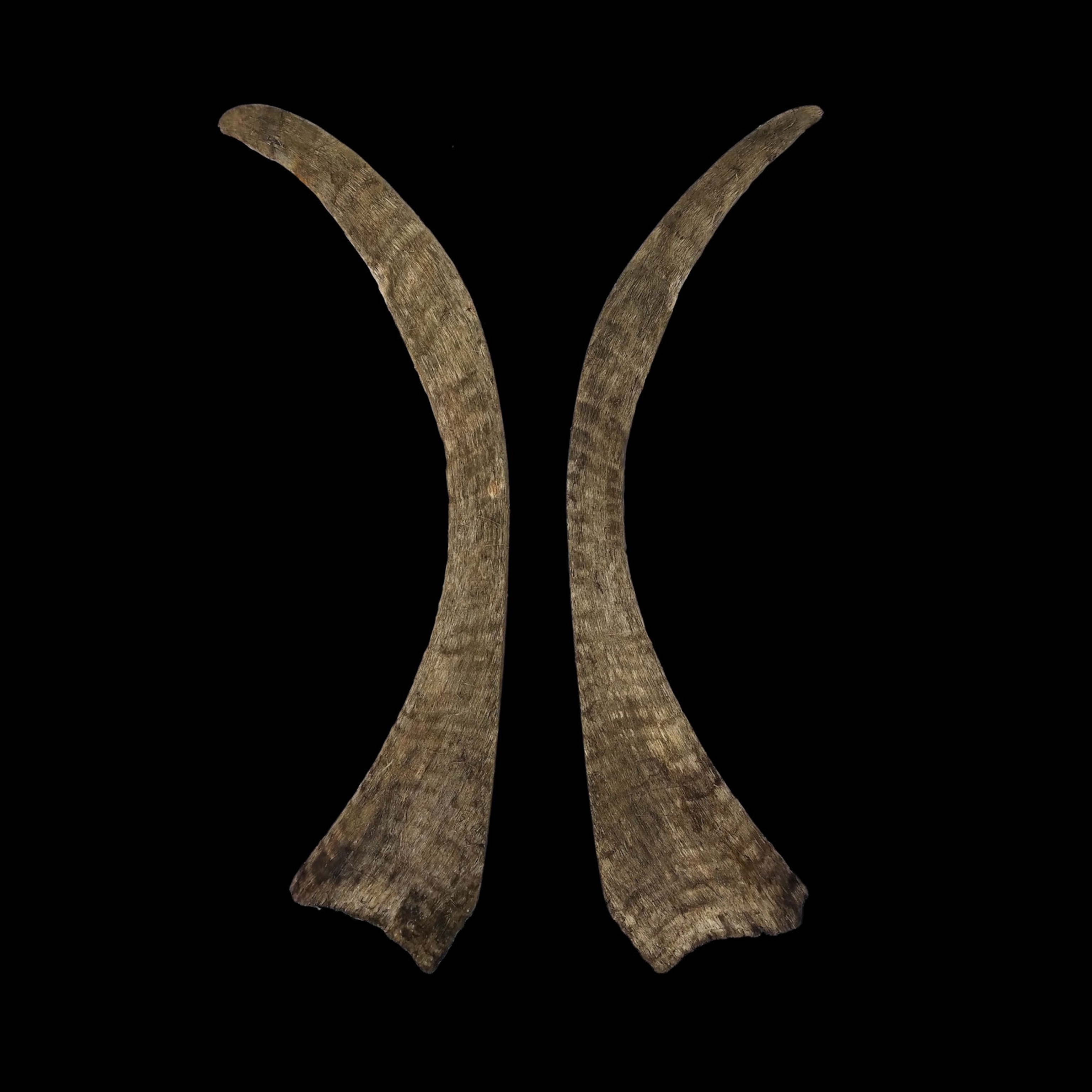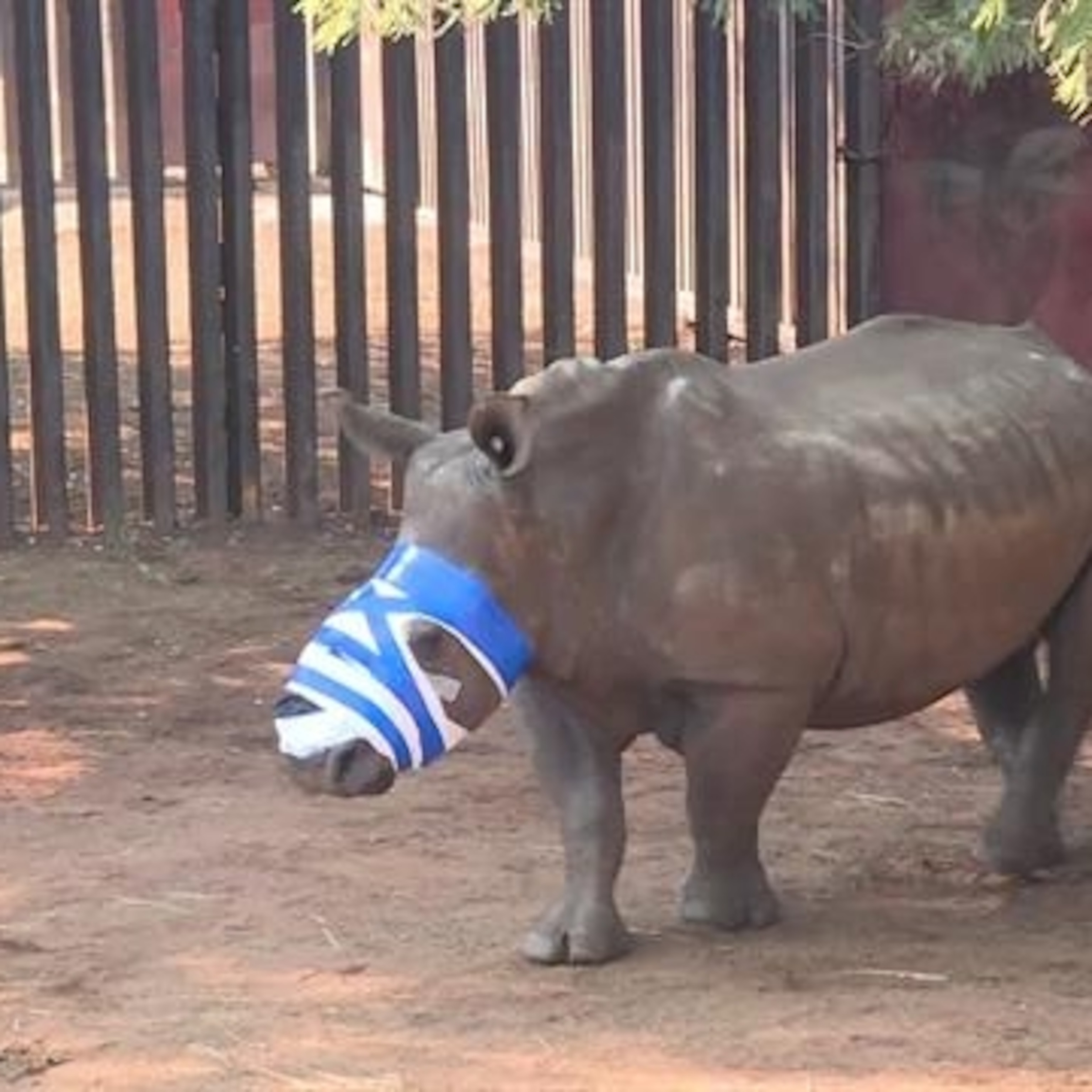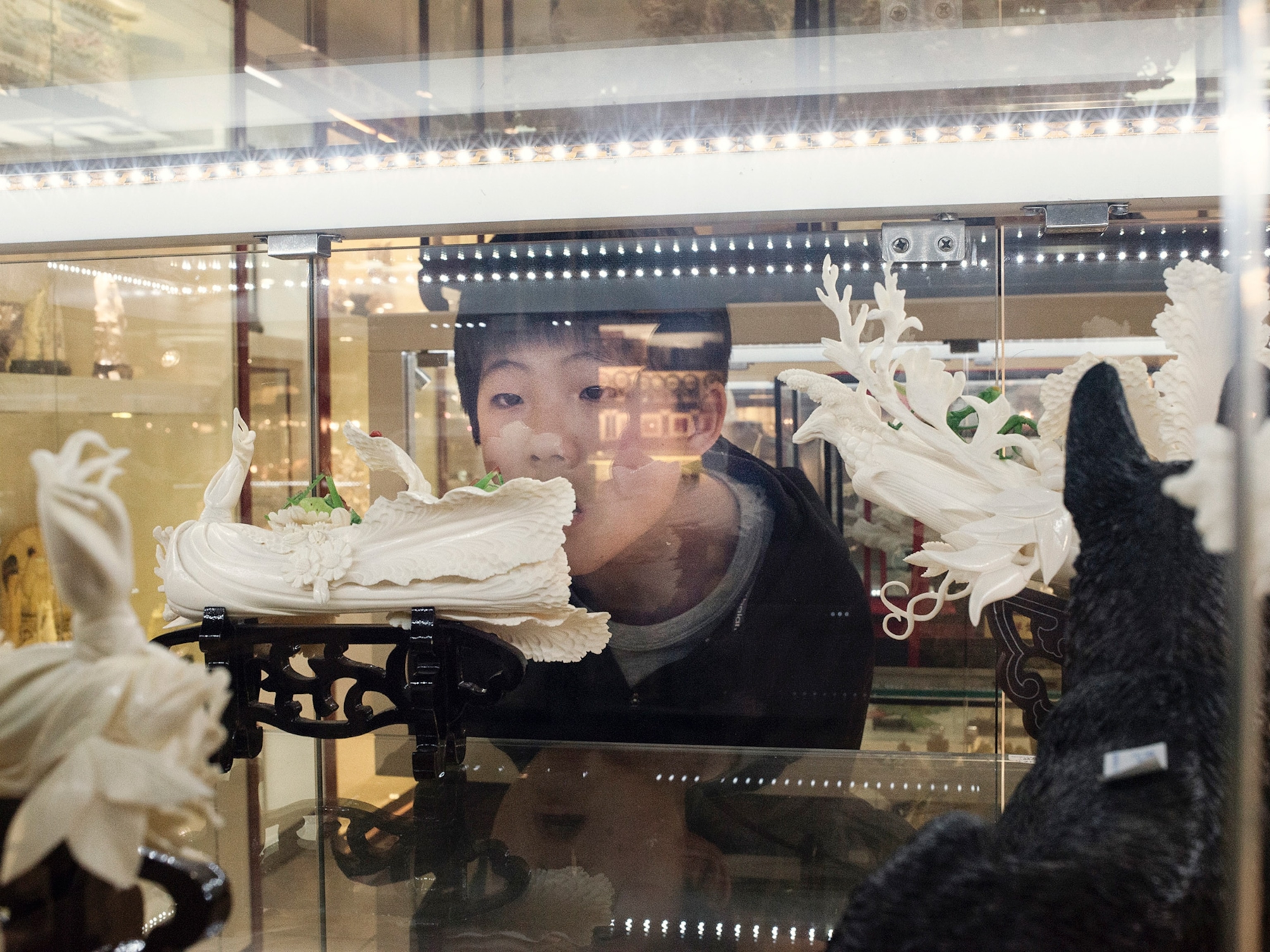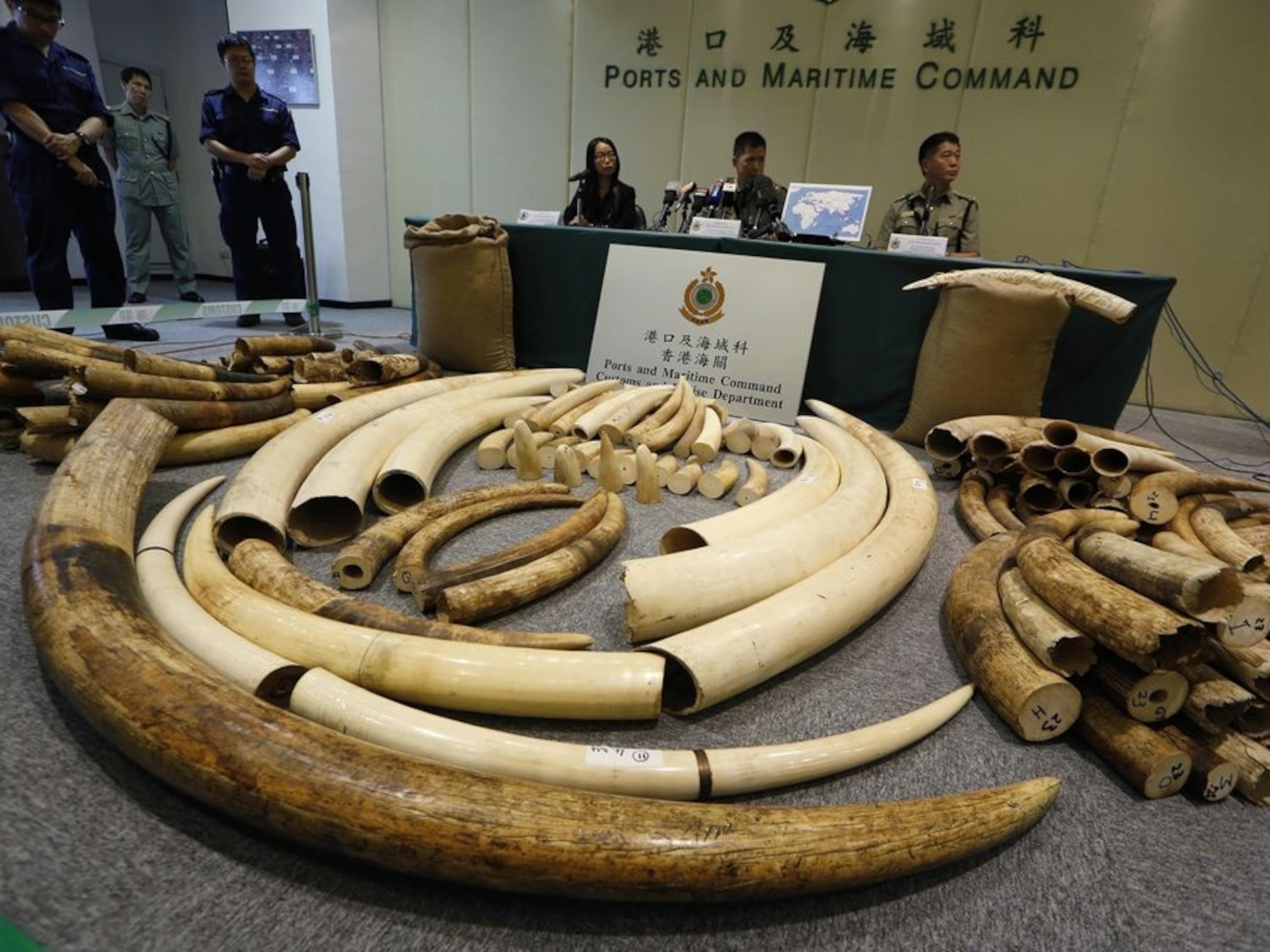Kenya Sets Ablaze 105 Tons of Ivory
The record-setting burn is meant to send a message to the world that ivory has no value and that its trade should be banned.
Nairobi, Kenya — Uhuru Kenyatta, the president of Kenya, bent over to light a tray of fuel, the eyes of a thousand observers fixated on his back. Looming in front of him was a massive tower of ivory—one of 11 starkly white pyres set up here at Nairobi National Park, a sprawling wildlife-filled oasis in Kenya’s capital city. Doused in fuel, smoke quickly began to billow from each of the intricately assembled piles. Bright orange blazes soon overtook them, blackening the formerly pristine pyramids.
By the time the last flames flickered out Saturday night, Kenya reduced 105 tons of elephant ivory and 1.35 tons of rhino horn to smoldering ash—the final remains of some 6,500 elephants and 450 rhinos killed for their tusks and horns. As President Kenyatta said in a speech early Saturday, the burn is meant to send a strong and clear statement to the world: “For us, ivory is worthless unless it is on our elephants.”
As widely reported here, Africa is in the midst of a poaching crisis, driven primarily by demand in Asia for wildlife products. Three-quarters of illegal ivory makes its way to China, while Vietnam is the largest market for rhino horn. Updated elephant population estimates, issued by the U.S. State Department in March, now hover around 400,000, indicating that one in five elephants have been killed for their tusks during the past 10 years. Last year 1,338 rhinos were killed for their horns, out of a total estimated population of just 25,600 black and white rhinos.
Ivory burns and crushes have become a popular but controversial method for nations to publicly assert their opposition to the illegal wildlife trade. Nearly 20 of those events have taken place in the past 27 years, in countries ranging from the U.S. to China and Gabon to the Philippines (see timeline). Kenya’s burn on Saturday, however, is by far the largest in history (Hong Kong held the previous record, destroying 28 tons in 2014). Still, Kenya’s burned ivory represents just 5 percent of what is currently held in government stockpiles across Africa.
A Heated Subject
But some nations have resisted displays such as the one Saturday, seeing them as a wasteful loss of a lucrative natural resource. Kenya’s stockpile would bring the country a windfall if sold today. South Africa, Namibia, and others—well aware of this—have held onto their ivory in hope of a future legal sale, said Paula Kahumbu, a National Geographic Emerging Explorer and CEO of WildlifeDirect, a Nairobi-based nonprofit dedicated to supporting African-led efforts to protect natural heritage.
“There’s a passing of judgment from some that we’re doing the wrong thing, because Kenya is a poor country, and we could use the $150 million-odd dollars that they claim the ivory is worth to develop our nation,” President Kenyatta said. “But I would rather wait for the judgment of future generations, who I am sure will appreciate the decision we have taken today.”
Countries that hoard ivory stocks “are speculators on an evil, illegal commodity,” added Richard Leakey, chairman of the Kenya Wildlife Service and chair of the Turkana Basin Institute at Stony Brook University, in a speech before the burn. “There can be no justification for speculating price rises in ivory down the road, and they should be shamed out of their position once and for all.”

Other nations, such as Botswana—which unveiled a tusk-based sculpture in the shape of an elephant in its international airport in 2014—say they prefer instead to use ivory in new artworks, as educational tools, or in museum displays. Tshekedi Khama, Botswana’s environment minister, told the Independent last week that his country will not destroy ivory because “burning ivory would demonstrate [to communities] that [elephants have] no value.”
That, however, is exactly the message Kenya wishes to deliver.
There are also practical reasons for destroying ivory. Keeping that material is expensive—requiring storage space and staff to guard it—and risky, since ivory has a tendency to find its way back into the black market through theft or corruption among those meant to watch over it.
“Protecting stores of ivory puts many people’s lives at risk, and making sure that it doesn’t get out has proven to be very difficult in many countries,” said Tim Tear, executive director of the Wildlife Conservation Society’s Africa Program. “The burning of it makes absolutely clear that it’s not getting into the illegal market.”
The hope is that Kenya’s burn will set an example for others to follow, encouraging formerly reluctant countries to get on board with destroying their own stockpiles.
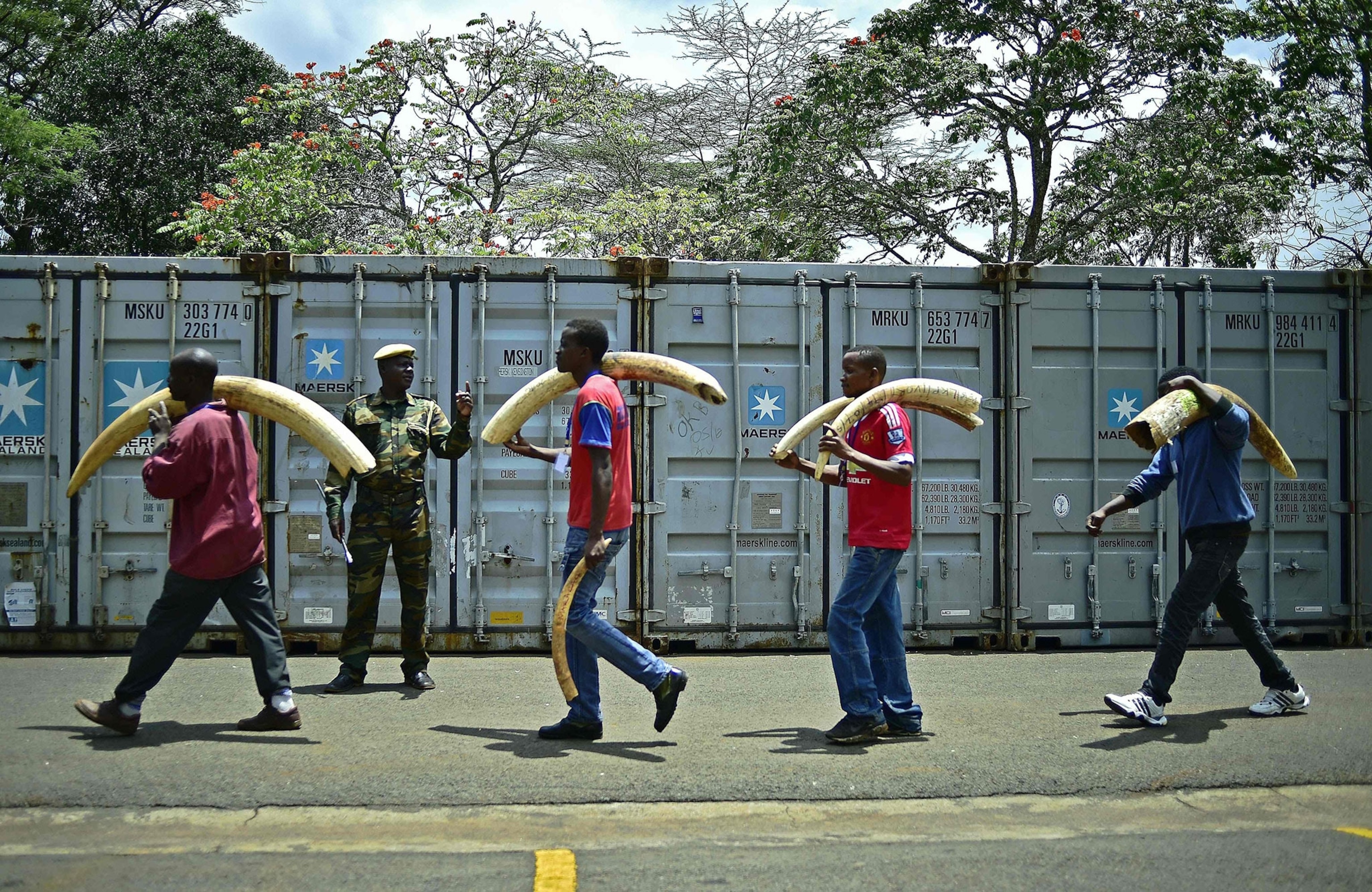
In some cases, the public is taking up that cry ahead of the government. Tanzania, for example, denied until last year that it had a poaching crisis at all, and it has long been a holdout on destroying any of its ivory. But on Thursday, the nonprofit group OKOA Tembo wa Tanzania (Save Tanzania’s Elephants) published a letter in Mwananchi, the country’s most popular newspaper, demanding the destruction of all ivory stockpiles, signed by 30 influential Tanzanians and supported by 100,000 Facebook followers.
“I think public opinion will turn very dramatically against ivory,” Leakey said. “The publicity that arises from this burn will spread to every corner of the globe, and people will learn that elephants are once again in a terrible state.”
History Repeats Itself
In a way, this burn takes Kenya full circle. Thirty years ago, Africa faced a similar poaching crisis, one largely driven by demand for ivory in Japan, Europe, and the U.S. The price of ivory jumped by a factor of 10 from 1969 to 1973, providing impetus for unchecked killings. The following 15 years saw the collapse of many of Africa’s elephant populations, reducing continent-wide numbers by half. Desperate to stem the losses, in 1989 Kenya pioneered a radical and headline-grabbing stunt: the world’s first ivory burn.
“In ’89 it was very much about shaming the people who were buying ivory, wearing ivory, and giving it as gifts—and it worked,” Kahumbu says. “Ivory is considered valuable now, but what we need is for the world to again see it as shameful.”
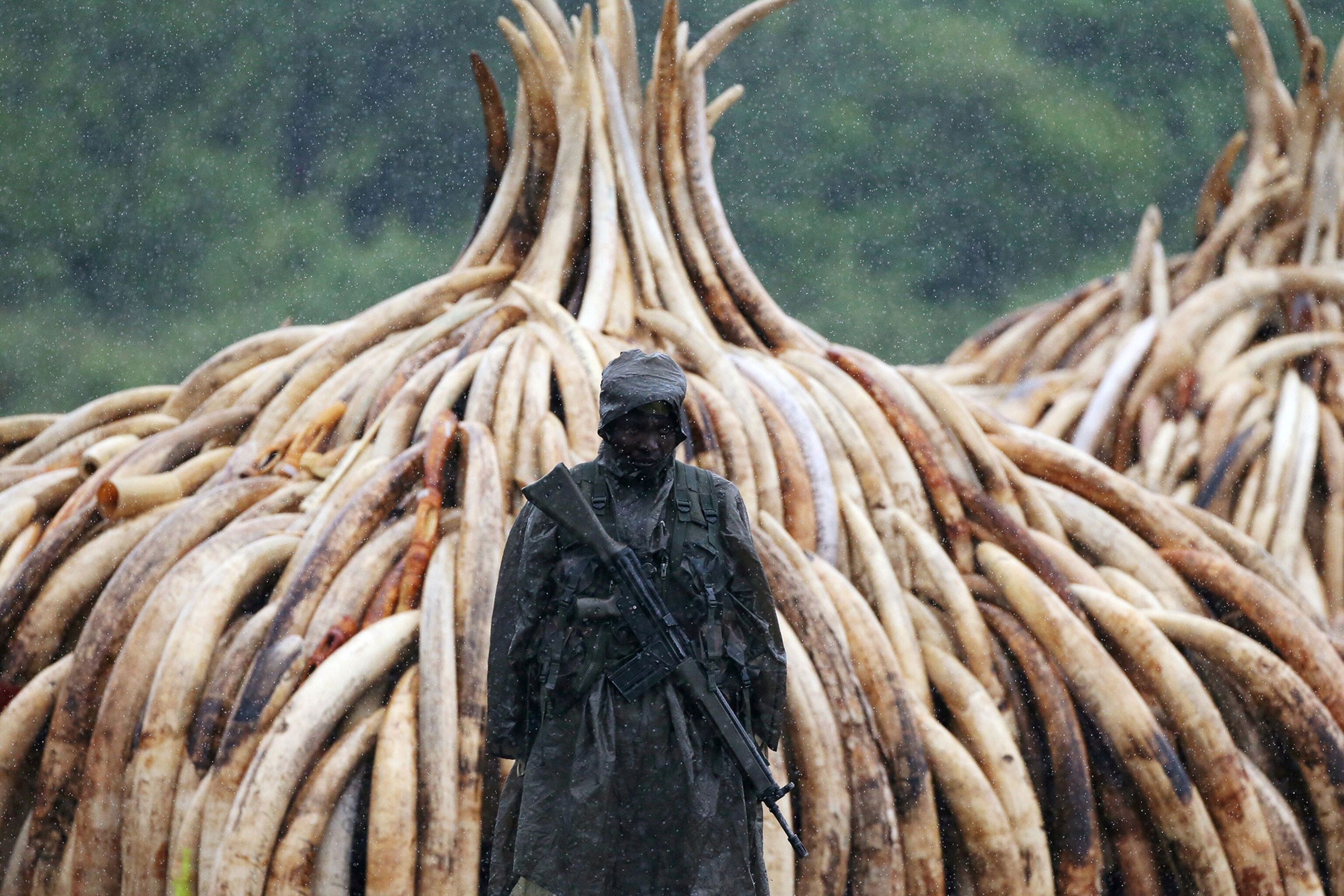
That first burn significantly contributed to the decision months later by the body that manages the global wildlife trade, the Convention on International Trade in Endangered Species of Wild Fauna and Flora (CITES), to ban all international trade of ivory. Under that reprieve, elephant populations slowly recovered. The protection was undermined, however, in 1997 and 2000 when Botswana, Namibia, South Africa, and Zimbabwe lowered the status of their country’s elephant populations under CITES, enabling limited ivory sales to Japan in 1999 and to Japan and China in 2008.
Proponents continue to argue that flooding the market with legally sourced ivory or rhino horn would curtail poaching pressure on animals while providing funds for conservation, but with the one-off ivory sales, ivory demand surged, and poaching intensified. In 2008, for example, Kenya lost 116 elephants, whereas in 2009, following the 2008 ivory sale, that number more than doubled, to 267. “Some people had this simplistic view that when they dumped ivory into China, it would depress prices and drive criminals out of business,” Kahumbu says. “But that’s not what happened: It triggered interest and caused the price to rise.”
Ban in the Making
President Kenyatta is aiming for Saturday’s burn to ignite policy changes that would, once again, completely remove ivory from the market. To solidify that goal, on Friday he joined Ali Bongo Ondimba, the president of Gabon, and Yoweri Museveni, the president of Uganda, at a conservation summit held in in Nanyuki, a town 90 miles north of Nairobi, along with international conservationists, philanthropists, and political representatives from Africa, the U.S., Europe, and China.
Organized by the Giants Club, an Africa-based nonprofit dedicated to securing the continent’s remaining elephant populations, the summit provided a platform for discussing methods to end poaching and strengthening commitments to do so. At the meeting’s end, philanthropists in attendance offered around $5 million in funding and support, while Gabon pledged to double its national parks staff from 750 to 1,500, and Botswana said it will create a special intelligence unit for supporting rangers.
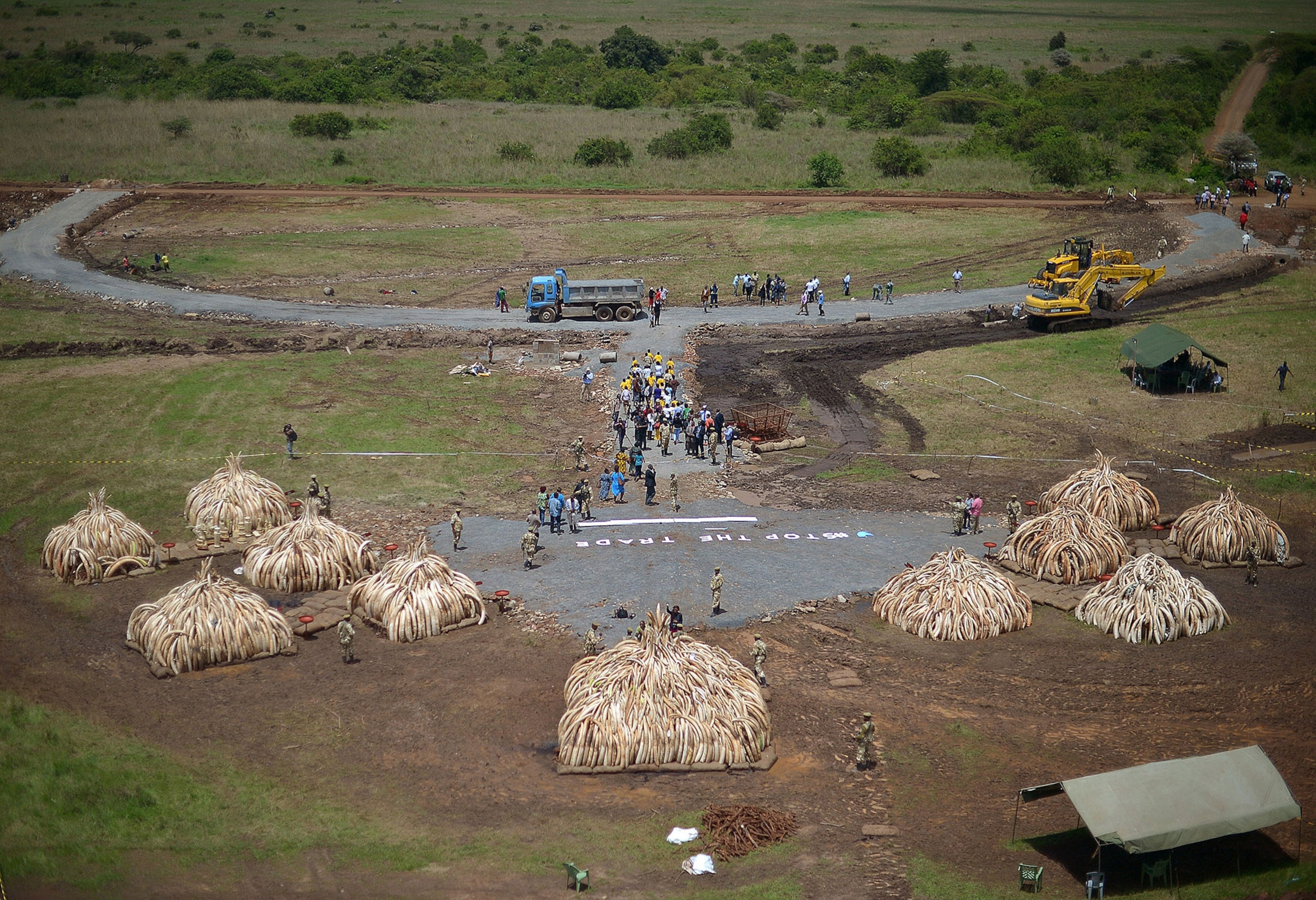
“The summit and the burn are about awareness raising and demand reduction, which are critically important, but the other part is simply action,” said Robert Godec, the U.S. ambassador to Kenya. “We’ll see what sort of pledges come out of this, hopefully.”
At the burn, Ségolène Royal, France’s energy minister, said she will ban all sales of ivory in France, and will strongly encourage other European Union states to do the same.
Plans to shut down all legal international trade in ivory have also been in the works for more than a year. In November 2014, representatives from 25 African nations signed the Contou Declaration, a joint statement calling for a global ivory ban. And earlier this week, the 27 member states of the African Elephant Coalition—a group of African countries committed to ensuring that elephants will have a future—submitted five proposals for the upcoming triennial meeting of the 182-member countries of CITES, in late September and early October in Johannesburg, South Africa.
The proposals call for re-listing all remaining African elephant populations at the highest level of international protection afforded by CITES, which would effectively shut down all legal international sales of ivory. “We cannot solve this global problem alone,” said President Ondimba of Gabon in a speech before the burn. “That’s why we, with Kenya and other nations, submitted a proposal to close all ivory markets.”
That plan’s success, however, is uncertain. “In terms of uplisting—good luck, but I don’t think it’ll work,” Kahumbu says. Rather than focus on CITES, she calls for China and countries in Africa and Southeast Asia to immediately shut down their domestic markets, and then work on implementing a global ivory ban.
The coming months will show which, if any, of those goals are realized. But in the meantime, Kenya asserts that it will do all it can to stamp out the trade.
“To lose our elephants would be to lose a key part of our heritage, and we quite simply will not allow it,” President Kenyatta said. “We will not be the Africans who stood by as that happened.”
Read more stories about wildlife crime and exploitation on Wildlife Watch. Send tips, feedback, and story ideas to ngwildlife@natgeo.com.
